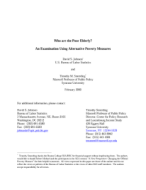
An official website of the United States government
Here’s how you know
Official websites use .gov
A .gov website belongs to an official government organization in the United States.
Secure .gov websites use HTTPS
A lock (
) or https:// means you’ve safely connected to the .gov website. Share sensitive information only on official, secure websites.
-
//
- Census.gov /
- Library /
- Census Working Papers /
- Who are the Poor Elderly? Report Using Alternative Poverty Measures
Who are the Poor Elderly? An Examination Using Alternative Poverty Measures
Who are the Poor Elderly? An Examination Using Alternative Poverty Measures
Abstract
This paper systematically reviews the recent literature on poverty measurement among the elderly by bringing together several related issues that bear upon measures of resources and needs for this important segment of the population. The NAS report, which began the recent poverty measurement debate, primarily focused on correctly measuring poverty among families with children, and hence, did not specifically examine the effects of their selected measures on the poverty status of the elderly. Subsequent research has focused more directly on the poverty of the elderly, both in terms of a resource measure and in terms of determining poverty thresholds and equivalence scales that accurately reflect the needs of the elderly as well as those of the nonelderly. This literature, however, has reached no definitive conclusion.
In this paper, we will show that the choice of equivalence scale and treatment of imputed rent both have substantial effects on the level and composition of elderly poverty, with the treatment of health care having the largest effect of all. This means that the consensus poverty measurement changes, suggested by the IRP group, leave many important unanswered questions about poverty among the elderly.
Due to both rising health care costs (especially the costs of prescription drugs) and the recent trend in withdrawal of retiree health insurance benefits, the cost of health care among the elderly is a major and growing national policy issue. We show that elderly poverty rates are sensitive to the treatment of medical benefits and medical expenses in the poverty measure. Depending on how these are valued, elderly poverty rates can vary by many percentage points. For instance, including a value of Medicare and Medicaid can decrease the official poverty rate by almost 2 percentage points, while the experimental measure presented in this paper (which subtracts MOOP from the resources) yields a poverty rate that is over 8 percentage points above the official rate. These differences suggest future research must examine the issue of how to treat health care for poverty measurement among the elderly.
Others in Series
Working Paper
Working Paper
Working Paper
Share
Related Information
WORKING PAPER
Supplemental Poverty Measure Working PapersSome content on this site is available in several different electronic formats. Some of the files may require a plug-in or additional software to view.
 Yes
Yes
 No
NoComments or suggestions?


Top

